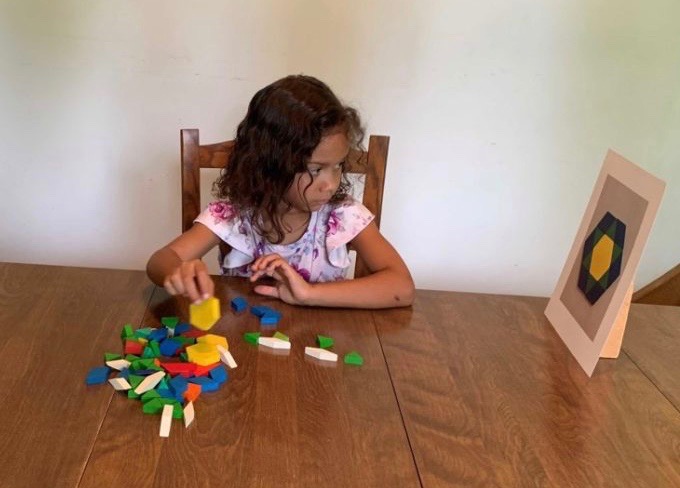1+ Players
Low teacher engagement
Materials
- Blocks (for example pattern blocks, building blocks, attribute blocks) or square color tiles
- Pictures of geometric designs or building structures (TIP: Use our provided set of pictures or take pictures of your own designs or block buildings. Premade templates or photos are also available online or may be in your classroom; many pattern block sets come with more complex templates.)
Setup — Less than 5 minutes
- Before you begin the activity, choose a picture (or set of pictures) based on the materials you have available and would like to use. (TIP: Start with simple designs or buildings. Designs that look like something familiar, such as a flower or a frog, are more engaging.)
- Display the picture so it is easily visible to children but so they cannot place blocks directly on the photo. (TIP: Have children work on a flat, firm surface, like a table.)
- Have children talk about their design to explore spatial relations, such as which blocks are on top of, in front of, next to, above, under, etc. other blocks. Children can also talk about the shapes of the blocks and how many there are
Instructions
- Have children look closely at the design or building shown in the picture.
- Ask children to copy the model using the materials you provided (e.g., pattern blocks) but without placing the blocks directly on the picture.

Checks for Understanding
To deepen children’s learning about early math concepts, talk and ask questions while doing this activity together. Here are some examples to get you started:
- “What shapes do you see in the picture? What block do you have that matches the one in the picture?”
- “How many blocks did you use?”
- “Do you want to start in the middle or on the edge?”
- “What block is below the triangle at the top of the building?”
- “If you want to start at the bottom of the design, what blocks do you need?”
- “What side of the block should touch the orange square? If you turn the block around, does it look the same?”
- “If you put those triangles together, what shape does it make?”
- “What shape is that part of the picture? What shapes do you have that you can put together to make the same shape?”
Activity Modifications
Here are some ideas to modify the difficulty level of the activity and keep it fresh and engaging all year long:
- Work with one block color or block shape at a time (e.g., place all the triangles first).
- Allow children to place the blocks directly on the design or building shown in the picture.
- Select pictures that show more complex designs or buildings that use more blocks or a wider variety of colors and shapes, or that include patterns within the design or building.
- Don’t provide any shapes that can be used in the design as is—instead, offer shapes that when put together create the shapes in the picture. For example, if the design uses squares, provide only triangles that can be placed together to create the same-sized square.
- With simpler designs, have children roll a die to determine how many copies of the structure to make, then have them create that number of copies.
- Practice estimation skills: “How many blocks do you think you will need to build this?”
- Before starting the activity, sort by size, shape, or color.
- Make each child responsible for a different set of blocks (e.g., “Violet has all the cylinders, Carlo has all the cones”)
- Have one child create a geometric design of a building, then have a second child make a copy of their design using the same or similar materials.